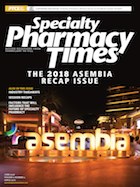Publication
Article
Specialty Pharmacy Times
Strategies to Support Patients Taking Oral Oncolytics
Author(s):
A Connecticut health system was able to transform the way it manages oral oncology services to improve patient outcomes and experiences.
A Connecticut health system was able to transform the way it manages oral oncology services to improve patient outcomes and experiences. During a session at Asembia’s Specialty Pharmacy Summit 2018, Sheila Talty, RPh, MBA, a health care executive at Yale New Haven Health System (YNHHS), shared the health system’s strategies to support the use of less- invasive chemotherapy drugs.
Adherence and clinical continuity are important to the modern program.
“We want our patients in our system the whole way,” Talty said. “All oral oncology comes to specialty pharmacy.”
In the past, YNHHS patients went to multiple pharmacies to fill prescriptions with limited availability and to find needed supplements. Some of these pharmacies are in locations far from the patient care site.
“We had patients going all over looking for drugs, going to the supermarket,” Talty said.
There was no formal documentation or process for patient education and patients were experiencing long delays in receiving treatment, said Talty. In addition, there was a lack of documentation for prescriptions or refills in the electronic medical records (EMRs) and the health system frequently didn’t know when or if patients had started treatment.
As a result, an in-house specialty pharmacy was created not only to enhance adherence, but also to improve the overall patient experience and help reduce medication errors. Since 2015, YNHHS has been building its in-house specialty pharmacy services for patients taking oral chemotherapy.
At first, YNHHS began filling specialty medications from its existing retail pharmacy sites at Yale New Haven Hospital. Within a year, the health system had expanded its specialty pharmacy footprint to a temporary space that afforded it the ability to increase resources and dispensing of specialty medications.
In early 2017, the first phase of a new, state-of-the-art 7500-square-foot facility for specialty pharmacy was completed. The second phase for the permanent facility doubled its size, allowing YNHHS to accommodate more resources and a higher volume of patient specialty medications.
Meanwhile, oral chemotherapies are becoming more widely used, with patients and prescribers moving away from intravenous (IV) chemotherapies. According to Talty, 30% of YNHHS’s oral chemotherapy patients are now leaving the hospital on the same day of treatment and two-thirds of oral chemotherapy patients are out of the hospital within 3 days.
“Our goal is to keep all of our oral chemo- therapy patients, and all of our patients, out of the hospital,” she told the audience.
As part of its program, the health system’s specialty pharmacy EMR hub provides a variety of services. It performs pharmacist clinical reviews and validation, provides medication delivery services, obtains all prior authorizations, coordinates and provides patient education, and offers medication adherence and quality measures, as well as continuous monitoring of adverse effects and toxicities, and medication assistance.
The specialty pharmacy program’s services are extended to patients long after an oral oncology prescription is filled. According to Talty, there is an initial therapy call within a day or 2 of treatment and an early follow-up call within a week.
Providing education to patients about their drug treatments is also an important factor to the program. Talty said at least one-third of 39 patients interviewed for a sample survey did not know how to take their medications. A lack of understanding about dosing was among the areas in need of attention.
For adherence management, Talty said new technologies are being considered, such as a smart pill bottle that tracks how frequently the bottle is opened.
In addition, YNHHS is not relying on automated phone systems to assist patients with pharmacy technicians answering live calls instead. These efforts are keeping patients out of the hospital and emergency departments, according to Talty.
“This is a really significant investment,” Talty said of the customer service initiative. “Our call stats are really, really impressive. We don’t measure this as how long a pharmacist is on the phone. We’re finding it has great value.”
Talty added that YNHHS is unique in that it offers stakeholders a choice between the use of oral chemotherapy and IV treatment.
"It's up to the patient. It's up to the provider. It's up to the payer. It's up to pharma," Talty said. "We are total choice, there is nothing mandatory about us."







